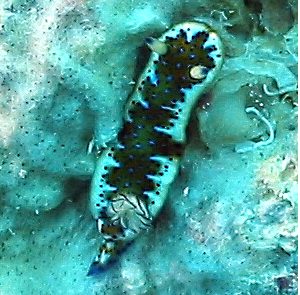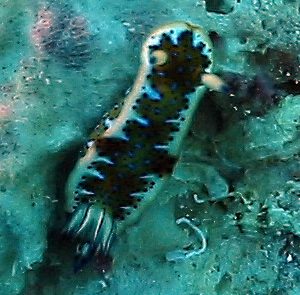Hypselodoris marci? from Florida
September 17, 2002
From: Craig Lavin

Note added 25 March 2008: This species, which has been called Hypselodoris sp. 5 on the Forum, has now been named Hypselodoris olgae - see message #22347.
You have a great forum! This Nudibranch was photographed in Key largo- It has the white edging break as H. marci does, however there is considerable variaion in the amount of brown/blue dots. I found it under a rock in about 25' depth, searching for nudibranchs...
The reef type was small spurs, with rubble between. Humann's book has the range listed as Uncommon, Northwest Caribbean, Venezuala, also south to Brazil. If so is this the first reporting from Florida for this species?
Please let me know, as I am a high school marine biology teacher, and this would make my class very excited!
Craig Lavin
clavin@attbi.com


Dear Craig,
I think your animal is one I already have on the Forum as Hypselodoris sp. 5. My edition of Humann [1992 edition, 5th printing 1999] doesn't have a species identified as H. marci but there is an unnamed one at the bottom of page 234-5, which looks quite similar. Your animal is identical to one identified as H. marci by Ortea, et. al (1996). However the big problem is Marcus' original description of H. marci. Her description is based on 2 preserved animals and a colour slide of what I presume is an animal from Brazil. She describes a red line along the mantle edge and describes the gills as red with a blue rachis. There are large blue spots forming a submarginal band along the mantle edge with a white background. She describes a black blotch about midway down each side, and describes the midregion of the mantle as white with 'small areas free around the blue notal glands. These stipples are often eye spots with a light blue center'. The rhinophores are blue-tipped.
I have great difficulty in understanding her description and her black & white drawing of th preserved animal suggest that the mid region of the mantle is light coloured with dark stippling, not a dark colour with some lighter spots as in your animal. In her discussion she suggests it is quite close to Hypselodoris acriba and I wouldn't be surprised if it turns out to be that species.
Tom Thompson (1980) reports an identical animal to yours from Jamaica but misidentifies it as Hypselodoris bayeri. So basically I think your animal is an unnamed species. However we cannot be sure of this until someone is able to sort out just what Hypselodoris marci is. Another good reason not to name new species from one or two preserved specimens. I wish the International Code was as strict in including essential characters in species descriptions as it was in getting the Latin correct.
What should you tell your class? One of the important lessons to get across is how little we know about our environment. Here is a perfect example. In waters lapping the coast of the most technologically advanced country in the world are animals we know nothing about and our funding agencies seem unwilling to fund the research needed to investigate them. The saddest thing is that technological advancement comes at an enormous cost in environmental degradation and these unknown organisms, in your own front yard, may be extinct before we even know of their existence.
References:
• Ortea, J., Valdés, A. & and García-Gómez, J.C. (1996) Revisión de las especies atlánticas de la familia Chromodorididae (Mollusca: Nudibranchia) de grupo cromático azul. [Review of the Atlantic species of the family Chromodorididae (Mollusca: Nudibranchia) of the blue chromatic group.] Avicennia, 1996, Suppl. 1: 1-165.
• Thompson, T.E. (1980) Jamaican opisthobranch molluscs: II. Journal of Molluscan Studies, 46(1): 74-99.
Best wishes,
Bill Rudman.
Related messages
-
Hypselodoris olgae feeding record from Florida
From: Linda Ianniello, May 20, 2009 -
Re: Hypselodoris sp. 5 from Key Largo, Florida
From: Vinicius Padula, March 25, 2009 -
Hypselodoris sp. 5 from Key Largo, Florida
From: M Katrina Smith, March 18, 2009 -
Hypselodoris sp. 5 from the West Indies
From: Jim Chambers, June 25, 2007 -
Hypselodoris sp. 5 - Key Largo, Florida
From: Paul Osmond, February 17, 2004 -
Re: Hypselodoris from Bonaire
From: Brian Mayes, May 28, 2003 -
Hypselodoris from Bonaire (Caribbean)
From: Brian Mayes, May 20, 2003 -
Hypselodoris sp. 5. from Florida
From: Anne DuPont, October 8, 2002 -
'Sea goddess' from Cayman Ids
From: Rod Dickson, January 27, 2002
